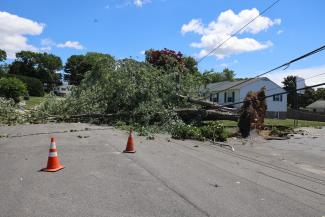Damage Assessment

RIEMA conducts a comprehensive damage assessment process to evaluate the impact of disasters on individuals, businesses, and public infrastructure. This process is crucial for determining eligibility for federal assistance and guiding recovery efforts.
-
Initial Damage Reporting
The Initial Damage Assessment (IDA) is a vital first step in the disaster recovery process, enabling RIEMA to understand the extent of a disaster’s impact and determine eligibility for state or federal assistance. The reporting process varies slightly depending on whether it’s an individual, business, private non-profit (PNP), municipality, or state agency. For individuals, businesses, and PNP’s, only after a significant event, the link to the form to report damages will be published to the media (social and traditional) and available on the RIEMA Website.
Completing this form:
- Is the first step in retrieving damage information from the public
- Does not guarantee assistance
- Does not constitute a claim or a request for disaster assistance
For municipalities, report damages using the RIEMA IDA form or the online platform.
For state agencies, report damages using the RIEMA IDA form.
Individuals (Homeowners and Renters)
Completing the form helps RIEMA and FEMA determine whether the Individual Assistance (IA) program is needed.
These forms collect detailed information about the primary residence only:
- Property details (e.g., address, ownership)
- Extent and type of damage (e.g., structural, contents)
- Insurance coverage
- Photographic evidence, if available
Businesses
To assess commercial losses and determine potential Small Business Administration (SBA) Physical Damage or Economic Injury Disaster loan eligibility.
These forms collect detailed information about:
- Damage to physical structures
- Loss of inventory
- Disruption to operations
- Business interruption insurance status
Private Nonprofits (PNPs)
To determine eligibility for FEMA’s Public Assistance (PA) or SBA assistance.
These forms collect detailed information about:
- Damages to buildings, equipment, and services
- Provide the details of the essential government-like services performed (e.g., education, utilities, health services)
Municipalities
To assess damages to public infrastructure and resources and to determine FEMA Public Assistance eligibility and funding for infrastructure repair.
Local municipalities compile reports on:
- Roads, bridges, schools, and public buildings
- Emergency protective measures taken (e.g., police/overtime, temporary shelters)
- Debris removal needs
State Agencies
To assess damages to state properties and resources and to determine FEMA Public Assistance eligibility and funding for infrastructure repair.
State Agencies compile information on:
- Damages to state-owned assets and facilities. Both are considered for recovery funding under the Public Assistance program.
- Submit detailed reports to RIEMA, typically coordinated through the agency’s emergency coordinator.
- Include damage estimates, supporting photos, and service impact narratives.
Final Notes on the IDA Process
RIEMA consolidates all reported damages to evaluate whether the disaster meets thresholds for federal declarations (IA, PA, SBA). Timely and accurate IDA reporting is critical to trigger potential federal assistance. RIEMA may deploy field teams or coordinate with FEMA for on-site validation.
-
Preliminary Damage Assessment (PDA)
RIEMA reviews the collected data to decide if a joint Preliminary Damage Assessment with FEMA is warranted. If so, RIEMA coordinates with FEMA to conduct on-site assessments, validating reported damages and estimating the cost of recovery.
-
Federal Disaster Declaration Request
Based on the findings from the PDA, the Governor may request a federal disaster declaration. If granted, this declaration enables access to federal assistance programs for affected individuals, businesses, and public entities.
-
Implementation of Assistance Programs
- Public Assistance (PA) - Provides financial support to state, local, and tribal governments, as well as specific non-profit organizations, for debris removal, emergency protective measures, and the repair or replacement of damaged public infrastructure.
- Individual Assistance (IA) - Provides aid to individuals and families affected by disasters, assisting them with temporary housing, home repairs, and other essential expenses.
- U.S. Small Business Administration (SBA)
- Physical Damage Loans: Available to homeowners, renters, nonprofit organizations, and businesses of all sizes. An Administrative (Agency) declaration is made when at least 25 businesses and/or homes (primary residences) in a county have uninsured losses of 40% or more of their estimated fair replacement value.
- Economic Injury Disaster Loans: Small businesses, small agricultural cooperatives, and most private nonprofit organizations located in a declared disaster area that suffered substantial economic injury may be eligible for an SBA Economic Injury Disaster Loan (EIDL).
SBA will make an Economic Injury Disaster Declaration when the Governor certifies that at least five small businesses in a disaster area have suffered substantial economic injury because of the disaster and need financial assistance not otherwise available on reasonable terms.
